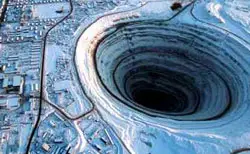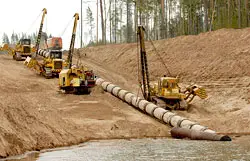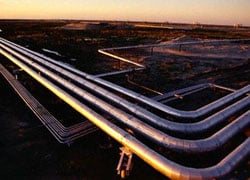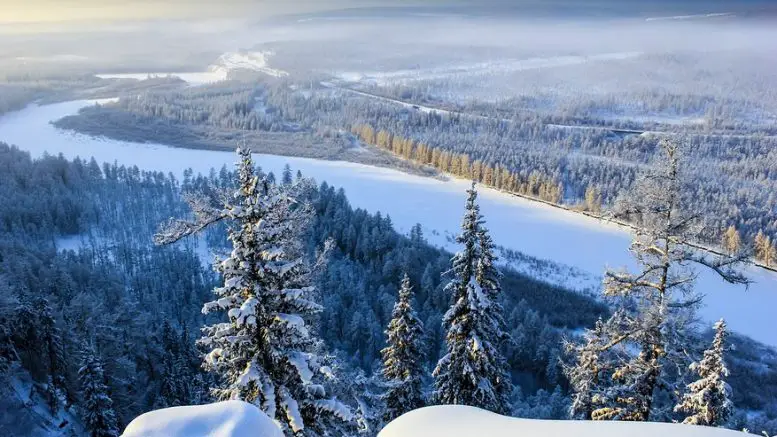
If Eastern Siberia declared independence, it would be the world’s seventh largest country – just below Australia. Yet, it would be only half as populous as Mozambique, which is the world’s 50th most populous nation. Eastern Siberia is rich in timber, diamonds, gold, coal, fur, copper, and tin and has deposits of petroleum, natural gas, and uranium. Perhaps because of its vastness, richness, and relative emptiness, Eastern Siberia seems to inspire human activity on a phenomenal scale. From the world’s longest oil pipeline, to the largest diamond mine, to the second longest railway tunnel, the region has long been the target of big dreams and ambitious plans – and yet remains, as it was, vast and relatively empty.

East Siberia is a vast land full of striking natural beauty.
Eastern Siberia is defined geographicly by most modern Russian sources as embracing the Yenisei River system in the west and ending at the Pacific watershed in the east. It differs from the Siberian Federal District, a political unit created in 2000 that does not include the vast Sakha Republic and does include several provinces attributed to geographic West Siberia – a move that may have been made to better the region’s vast mineral wealth. However, if we examine the region’s topography and water systems, two of the most important factors in determining the flow of economy, warfare, migration, and history, we can see that Eastern Siberia should extend a good deal east from the federal district, although where it exactly it should end is debated by scholars.
The landscape of the region is highly diverse – spanning arctic desert in the
Following the conquest, Russians took over from the Tatars in extracting tributes – usually in the form of furs or other resources – from the various tribes inhabiting the area. Siberia as a whole also quickly became valuable to Russia’s rulers as a destination to exile criminals. The most famous of these exiles were the “Decembrists,” a group mostly comprised of nobles who called for the end of serfdom and autocracy and who refused to swear allegiance to the new Tsar, Nicholas I. On December 14th, 1825, they led an uprising on Senate Square in St. Petersburg. It was crushed within a few hours and the conspirators immediately hanged or exiled to the Eastern Siberian city of Irkutsk, which they then turned into a cultural and economic powerhouse for the region. Indeed, exiling prisoners to Siberia seemed to be as much an economic development policy as it was a penal policy – as witnessed by the forced labor camps that would also dot the Siberian landscape.

The enormous Mir Diamond Mine, located in central Eastern Siberia, once gave yields of two million carats per year. It was abandoned in 2004. Note the roads, warehouses, and other buildings to the left.
The economic development of Eastern Siberia, however, has always been hampered by its distance from Moscow and lack of roads; a trip from Moscow to Yakutsk took more than three muddy months for travelers in the 19th century. The problem, which continues today, is a result of centuries of poor management and Eastern Siberia’s severe weather, which fluctuates between frigidly cold winters to wet springs to blisteringly hot summers, and which makes road construction and maintenance a difficult and expensive venture.
Large-scale settlement and exploitation of the region began only with the construction of the Trans-Siberian Railroad (1892-1905). Cities along the railway flourished – as did agriculture and other industry. The railroad was gradually expanded with what would become the Baikal-Amur Magistrate (BAM), which begins in Eastern Siberia and runs through the Russian Far East. The BAM includes the Severo-Myisky tunnel – the world’s second longest railway tunnel, which was finally completed in 2001 after more than 15 years of struggle with the Baikal Mountains and funding issues. Yet the BAM was built primarily for military purposes – to be used in the event of an attack from neighboring China – and little attention seems to have been paid to its potential civilian use. It has been criticized as poorly planned and its economic impact to the area has been minimal.
Eastern Siberia is facing many problems today. It suffers from underinvestment in 
Yakutsk is growing (though not spectacularly) in terms of both population and economy. This is despite the fact that its residents face -40C winters and there is no overland route to the city that can be used year-round. Yakutsk has become regional base for mining companies such Alrosa, an Russian-owned international giant accounting for 20% of the world’s supply of rough diamonds. The nearby Mir Diamond Mine still holds the world record for the world’s largest diamond mine ever dug. At three quarters of a mile wide and a third of a mile deep, it took trucks nearly two hours to wind to the top and today the airspace above it is closed because it can and has “sucked in” aircraft. The mine was closed in 2004.
Irkutsk is also an aspiring regional center. It has always been a logistical center for trade with China, Russia’s number three trade partner. Much of that trade is shipped via railway, joining with the Trans Siberian in Irkutsk. The city recently developed an ambitious, highly controversial plan to incorporate surrounding towns into itself to create a metropolis of more than one million people. The increased federal funds it would then qualify for would be used to build public transport and tourism infrastructure. However, the independent surrounding towns oppose the plan and critics question why Irkutsk needs three new tourist resorts when its schools and hospitals desperately need refurbishing. The plan could also have a negative environmental impact on nearby Lake Baikal, the world’s deepest (1,700 meters) and oldest (25 million years) freshwater lake. Called “the most outstanding example of a freshwater ecosystem on the basis of natural criteria,” the lake was declared a World Heritage Site in 1996.

The road, as it currently exists, which leads to Yakutsk
Baikal faces another potential threat from the new Eastern Siberia-Pacific Ocean Oil Pipeline, which will be the world’s longest oil pipeline when completed. Beginning in Eastern Siberia at Taishet (between Krasnoyarsk and Irkutsk on the Trans-Siberian Railway), it will stretch all the way to the Pacific to supply China and Japan, the world’s second and third largest consumers of oil. The first portion of the pipeline should be completed in late 2009. However, the region’s propensity for seismic activity creates a high risk of pipelines bursting, and the resulting environmental concerns have caused numerous delays already.
The southern portion of Eastern Siberia is well-suited to agriculture, and although while ranching is becoming a major industry in the province of Chita, the agricultural potential of Siberia has never been fully harnessed. The central portion of the region is also rich in timber, which has traditionally been a major industry for Russia – but transportation issues currently make developing this industry difficult. However, Eastern Siberia, if independent, would have the world’s largest forest reserves. Given rising demand for paper and wood products, particularly in China, finding a method to bring sustainable development to these forests could bring rich profits.

construction of the first phase of the Eastern Siberia-Pacific Ocean Pipeline is already underway.
These types of land-intensive industries would be effective at bringing more wealth and opportunity to many citizens in Siberia. However, the region is also home to more than 120 nationalities, many of them still living traditional nomadic lifestyles that require open land. Many of these peoples have never been extensively studied or documented. Some of these include the Keto (700 people), Ngasany (800 people), and Entsy (200 people). The Keto people, for example, are an exotic nation of enigmatic ancestry with a language similar to some languages of the Basque, North American Indians, and natives of the Caucasus.

Completed pipeline in East Siberia.
Eastern Siberia’s phenomenal wealth and size offer incredible potential for the developing Russian economy. However, despite nearly four centuries of efforts by some of the world’s most ambitious dreamers and planners, despite Russia’s proven ability to perform fantastic feats of engineering and complete spectacularly large projects, that potential is yet to be fully realized.
Although Russia was the first country to conquer a bit of the cosmos by sending one of its citizens outside the earth’s atmosphere, establishing a permanent and sustainable presence in such a remote, vast, and inhospitable territory requires considerably more planning and investment. This can be difficult for any one country to achieve, even with the oil wealth of Russia or the economic might of the US. The international participation in the international space station shows this. Likewise, it will be only with considerable international help that Russia will manage to eventually plan, fund, and implement the sustainable development of Siberia.




